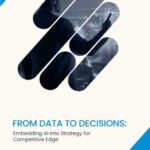or call: +1 (845) 347-8894

or call: +1 (845) 347-8894

In 2011, IBM’s Watson stunned the world by outperforming human contestants on Jeopardy!. While that moment marked a milestone for natural language processing, it also hinted at something bigger: the role artificial intelligence could play in navigating human knowledge. Over a decade later, we are witnessing a far more practical and transformative shift, particularly in how businesses educate and empower their people, especially through the application of AI in personalized learning for B2B companies.
Today, AI is reshaping the learning landscape across industries. For B2B companies, which often manage large, diverse workforces with complex training needs, traditional learning methods are no longer sufficient. The demand has shifted toward highly adaptive, personalized education that aligns with job functions, industry dynamics, and individual learning styles. Artificial intelligence stands at the heart of this transformation. AI in personalized learning for B2B companies is not just a trend; it’s becoming a critical differentiator in driving performance and growth.
This article explores 10 key ways AI is advancing personalized learning for B2B enterprises, helping organizations deliver smarter, faster, and more relevant knowledge across every touchpoint.
In most corporate environments, understanding which skills an employee lacks has long relied on manager assessments or outdated testing formats. AI takes a much more dynamic approach. By analyzing a combination of user interactions, content engagement, job performance metrics, and even team communication patterns, AI systems can determine which competencies need attention at both individual and departmental levels.
This allows companies to deliver hyper-targeted content that addresses actual, measurable gaps, not just what the learner thinks they need. For example, if a sales team consistently underperforms on deal closures involving a specific product, the AI system might suggest micro-courses on that product’s technical benefits or objection handling. The insight is contextual, grounded in behavior, and far more actionable.
Every employee processes information differently. Some prefer step-by-step visual guidance, while others absorb material better through hands-on tasks or audio content. AI can track these preferences and make real-time adjustments to each learner’s journey.
Adaptive learning systems use behavioral data to present content in a sequence and format best suited to each individual. For example, a new team member might start with more foundational content, while a more experienced colleague is guided toward advanced modules. As the learner progresses, AI continually refines the path, ensuring consistent challenge without overwhelming them.
This kind of adaptation isn’t just about convenience, it leads to higher retention, more engagement, and quicker application of skills in real-world scenarios.
B2B professionals often work within demanding schedules. Traditional training sessions can disrupt workflows and reduce productivity. Microlearning, powered by AI, changes this dynamic by breaking down content into brief, actionable lessons that fit into daily routines.
AI tracks user behavior and identifies when a learner is most receptive, for instance, right after completing a task or before a scheduled meeting. Based on these cues, it pushes small pieces of content that reinforce a concept, introduce a related skill, or prepare the user for an upcoming objective.
The advantage lies not just in brevity but in timing. When content is delivered contextually, it has a far greater chance of being absorbed and applied. Over time, this creates a continuous, unobtrusive learning loop embedded in the workday.
Most training systems react to user performance. AI-enabled platforms, by contrast, predict outcomes. By analyzing patterns in how employees engage with content, complete tasks, and respond to assessments, AI can forecast future behavior.
For example, it might detect that a learner’s drop in engagement signals the early stages of burnout or disengagement. It can also anticipate which employees are most likely to benefit from leadership development programs based on their trajectory and learning agility.
These insights help HR and training teams act before problems arise. Whether through personalized nudges, coaching recommendations, or curriculum adjustments, predictive analytics enables proactive support at scale.
Standardized assessments often fail to capture a learner’s real abilities. AI introduces a more fluid approach. As users interact with learning platforms, their choices, completion times, and comprehension levels are constantly evaluated.
This allows for on-the-fly adjustments. If a learner struggles with a topic, the system may insert a simplified module or supplemental explanation. If they master it quickly, the content becomes more complex. Feedback becomes immediate, personalized, and actionable, replacing generic scorecards with meaningful progress insights.
Moreover, trainers gain access to granular data that shows not just whether someone passed a quiz, but how they approached it, which areas they hesitated on, and what concepts they misunderstood.
When employees look for learning materials, they don’t always know the correct terms. Traditional keyword-based search systems fail them. AI leverages natural language processing (NLP) to interpret complex queries and return contextually relevant results.
Instead of typing “customer retention framework,” a user might ask, “How can I keep clients from churning?” NLP understands the intent and delivers the appropriate learning asset, even if the terminology doesn’t match exactly.
For B2B firms, especially those with vast content libraries or multiple internal systems, this functionality reduces friction and saves time. AI in personalized learning for B2B companies improves access by making knowledge retrieval intuitive and aligned with real-world language.
Another major benefit of AI is the introduction of virtual coaches, intelligent assistants embedded within learning systems. These AI agents provide immediate help, suggest resources, answer questions, and guide users through challenging topics.
Unlike static FAQs or forums, these coaches learn from user behavior. They evolve with the individual, offering more relevant support over time. In organizations with decentralized teams or 24/7 operations, virtual coaching ensures continuous, consistent learner support without human intervention.
In essence, it’s like having a personal tutor available around the clock, capable of anticipating questions before they’re asked.
Generic learning content doesn’t serve today’s B2B landscape. Sales teams in the pharmaceutical sector need different information from software developers in finance. AI can distinguish these differences and recommend content tailored to the user’s specific context.
It curates material from both internal repositories and external sources, filtering it by relevance, credibility, and recent trends. Over time, as the system observes which content performs best for which roles, it refines future recommendations.
This level of specificity allows organizations to ensure that training remains directly aligned with business goals and current market dynamics, rather than offering irrelevant or outdated knowledge.
Learning isn’t always a solitary pursuit. AI encourages peer collaboration by identifying and connecting employees with complementary skills, similar challenges, or shared interests. This type of smart pairing can lead to mentorship, joint problem-solving, or group training initiatives.
For instance, an employee excelling in a particular technology could be matched with someone struggling in that area. AI facilitates the interaction, tracks outcomes, and adjusts future recommendations based on success.
Such peer-to-peer models enhance team cohesion, accelerate learning, and foster a culture of knowledge sharing, all essential qualities for B2B organizations navigating rapid change.
Perhaps the most strategic benefit of AI lies in how it enables systems to improve over time. Every click, quiz attempt, video view, or content completion becomes part of a data ecosystem that AI can analyze.
Learning and development teams gain access to real-time dashboards showing which modules resonate, where drop-off rates are highest, and which delivery formats yield the best results. This ongoing feedback loop empowers teams to revise and reframe programs continuously.
Rather than launching a course and revisiting it once a year, organizations can iterate weekly or monthly, ensuring content relevance and learner satisfaction. This agility is vital for B2B firms responding to technological, regulatory, or competitive shifts.
The future of B2B success will depend less on static knowledge and more on adaptive intelligence, both in systems and people. Artificial intelligence is more than a tool for automation. It is a strategic enabler of growth, learning, and innovation.
By embedding AI into their learning ecosystems, B2B organizations can move beyond outdated models and into a new era of skill development, one that is personal, predictive, and performance-driven. Those who lead this shift will not only cultivate stronger teams but also position themselves as industry leaders in a world where change is constant.
Personalized learning ensures that each employee receives training aligned with their role, skill level, and career goals. For B2B companies, this leads to improved productivity, higher engagement, faster onboarding, and stronger alignment between individual growth and organizational performance.
AI uses data from user behavior, performance metrics, and learning preferences to adjust content delivery in real time. It creates custom learning paths that evolve as the user progresses, ensuring a tailored experience that maximizes retention and effectiveness.
Predictive analytics identifies patterns in learner data to forecast outcomes such as skill gaps, training completion risks, or high-potential talent. This enables proactive decision-making and personalized interventions before performance issues arise.
Yes, AI-powered systems continuously monitor user interactions and performance. This allows for instant feedback, dynamic difficulty adjustments, and accurate tracking of mastery levels far beyond what traditional assessments offer.
Start by identifying areas where personalization or automation is needed. Choose a scalable AI-powered personalized learning platform, pilot it with a small team, analyze results, and iterate based on feedback. Align the initiative with business objectives to ensure measurable outcomes.
To participate in our interviews, please write to our IntentTech Media Room at sudipto@intentamplify.com




